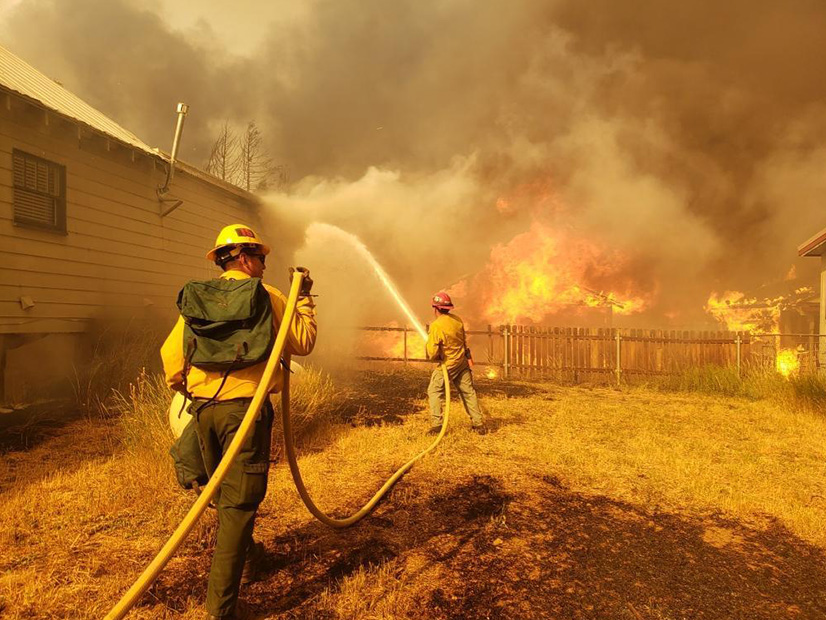
Pacific Gas and Electric (NYSE:PCG) ended five years of probation Tuesday night with the judge in charge lamenting that California’s largest utility had caused more damage on probation than it had before it was sentenced.
PG&E was placed on probation in January 2017 after being convicted of six felonies related to the San Bruno gas explosion, which killed eight people and destroyed a suburban San Francisco neighborhood in September 2010.
“While on probation, PG&E has set at least 31 wildfires, burned nearly 1.5 million acres, burned 23,956 structures and killed 113 Californians,” Judge William Alsup, of the U.S. District Court for Northern California, wrote in his parting comments on the case.
The utility pleaded guilty to 84 manslaughter charges in the 2018 Camp Fire, which leveled the town of Paradise, Alsup said. It faces five felony counts in the 2019 Kincade Fire in Sonoma County and four manslaughter charges from the 2020 Zogg Fire in Shasta County. The Dixie Fire, ignited by PG&E equipment last summer, was the second largest in state history at nearly 1 million acres and will likely result in lawsuits and possibly criminal charges, he said.
“So, in these five years, PG&E has gone on a crime spree and will emerge from probation as a continuing menace to California,” Alsup said.
“Rehabilitation of a criminal offender remains the paramount goal of probation,” he said. “During these five years of criminal probation, we have tried hard to rehabilitate PG&E. As the supervising district judge, however, I must acknowledge failure.”
Alsup told federal prosecutors on Jan. 3 that he would give “serious consideration” to a request for more probation time based on the state criminal charges against PG&E, but the U.S. Attorney’s Office decided not to seek an extension. (See Judge Refrains from Adding Time to PG&E Probation.)
PG&E Responds
In a November court filing, PG&E assessed its own progress on probation, often in contrast to the judge’s remarks.
“PG&E acknowledges, deeply regrets and owns the tragic consequences of the wildfires caused by its equipment,” it said. “The company has taken a stand that catastrophic wildfires shall stop.” But during the past four years, thanks in part to the court’s supervision, its “electric grid is fundamentally safer.”
“PG&E believes it is on the right path,” it said. With its 70,000-square-mile service territory and the speed at which climate change appears to be impacting Northern California, there are “no fast or fail-proof options,” but the utility insisted it has changed.
PG&E is now “led by a board and senior management team that is new compared to those in place at the time of the San Bruno tragedy, the North Bay fires [in October 2017] and the Camp Fire,” it said. “Recognizing the need for the best thinking on operations, safety and risk, the company has hired leaders from stable, safe and operationally excellent utilities around the country,” including new CEO Patti Poppe, former head of CMS Energy in Michigan.
PG&E cited its use of public safety power shutoffs to prevent ignitions, which it did not use in 2017 but now employs widely in fire season along with fast-trip sensors to shut down power lines when faults occur.
The utility contended it has greatly improved its vegetation management. Trees and limbs falling on power lines have caused many of the major fires in the past five years.
“Between 2017 and 2021, PG&E increased spending on vegetation management from approximately $440 million a year to approximately $1.4 billion, representing an over 200% increase,” it said. “The total number of employees and contractors dedicated to vegetation management rose from 4,446 in 2019 to 10,265 in 2021.
“These unprecedented monetary and workforce investments have resulted in a significant amount of additional work,” it said. “In 2021, PG&E has removed or trimmed over 1.63 million trees as of Oct. 31 and forecasts it will remove or trim 1.82 million trees in total by year-end, a 20% increase over the 1.52 million trees worked in 2019.”
Alsup, however, said tree trimming remains one of the utility’s biggest problems.
“We remain trapped in a tragic era of PG&E wildfires because for decades it neglected its duties concerning hazard-tree removal and vegetation clearance, even though such duties were required by California’s Public Resource Code,” Alsup said. “In time, this neglect led to hazard trees and limbs falling on its distribution lines and sparking wildfires or becoming ‘ground faults,’ wherein the tree remains against a live wire and conducts sufficient electrical power to the earth to overheat and explode in flames.
“PG&E’s backlog of unattended trees and vegetation was staggering at the outset of probation,” he said. “As probation ends, PG&E remains at least seven years, [in] my estimate, from coming close to being current. During its criminal probation, all or virtually all of the wildfires started by PG&E distribution lines have involved hazard trees.”
The Camp and Kincade fires were started by broken transmission lines that ignited dry vegetation, he noted.
Alsup said he believes a “systemic cause” of distribution-line fires has been PG&E’s outsourcing of tree trimming and line inspections.
“A large part of the wildfire problem, as the [court-appointed] monitor has pointed out, has been sloppy inspection and clearance work, almost exclusively outsourced to independent contractors,” he said. PG&E should hire and train “as many arborists as are needed to fully comply with California’s Public Resource Code,” and the state should outlaw or restrict outsourcing.
The utility’s size is another problem, Alsup continued. PG&E operates 107,000 circuit miles of distribution lines and 18,500 miles of transmission lines, with about half its territory in high fire-threat districts.
Alsup said he has “come to fear” that PG&E should be split into at least two entities, one to serve fire-prone areas and one or more to serve the rest of its 5.5 million electric customers.
“Less sprawling utilities would be easier to train and to instill practices and procedures that truly put safety first.”

